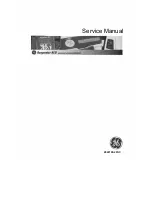
XS series operating manual
XS user manual v0.55
- 135 -
Measurements on cables
The measurement on cables is similar to the measurement on capacitors
The measurement configurations on cables are very varied. The measurements have to be performed
either between each conductor for multi-wires cables, either between main conductor and shielding for
shielded cables, either between the cable and its environment for mono-wire cables.
A) In that last case, the generally used way is to immerse the cable reel in a water tank (called
SWIMMING POOL), to wait for the water penetration in to the cable reel center, and then to perform
the insulation resistance between the cable and the water. For safety and construction reasons the
water tank is grounded. The insulation resistance measurement unit must be able to measure a
specimen with one grounded end. The units of the MG series allow performing easily this type of
measurement, because the hot point of the high voltage generator is already grounded. You just have
to connect the measurement input of the unit (with the HV probe) on the cable to be measured and to
trigger the measurement.
B) Another specific point, when measuring on cables, is that the specifications of the cable
manufacturers give resistance values for a standard length of cable equal to 1 km (1000 meters).
When testing the reels of cable, those are never equal to the standard length, that forces the
operators to calculate the resistance as a function of the cable length and the number of wires in
parallel for the multi-wires cables. Consequently the built-in comparators of the measurement units
can not be used, because they compare regarding to the total insulation value and not regarding the
standard value. The units of the MG series allow with the option 23 to display insulation resistance
measurements reduced to 1 km and 1 wire, and therefore allow the use of the built-in comparators.
The operator can enter in a specific menu of the unit the length of the cable under test as well as the
number of wires. The result is given in Mohm per km.
i.e. : the unit measures a value of 10 Mohms for a 10 km long mono-wire cable. Therefore, the value
reduced to 1 km will be :
(Rtotale / 1 km) x Length = 100 Mohm.km
For the same cable with 10 wires, the value for 1 wire will be :
100 Mohm.km x 10 = 1000 Mohm.km
C) The insulation resistance value of a cable being a function following a time exponential law, it is
important to make sense to the measured value, to indicate the duration of the measurement. The
units of the MG series allow complying with this requirement with the built-in timer, able to measure
times going from 1 second up to 16 minutes.
Measurement voltage selection
The insulation resistance measurements intending to verify that materials or equipments comply with
standard requirements, it is important to refer to these standards to select the voltage. The standard
voltages are generally : 50, 100, 250, 500 VDC.
In case of no standard, select a 100 VDC value.
When measuring on capacitive specimens and when studying the voltage influence on the insulation
resistance values, it is important to start always with the lowest voltage and then to follow the
measurements in increasing the voltage. A procedure in the reverse way could give incoherent results.
















































